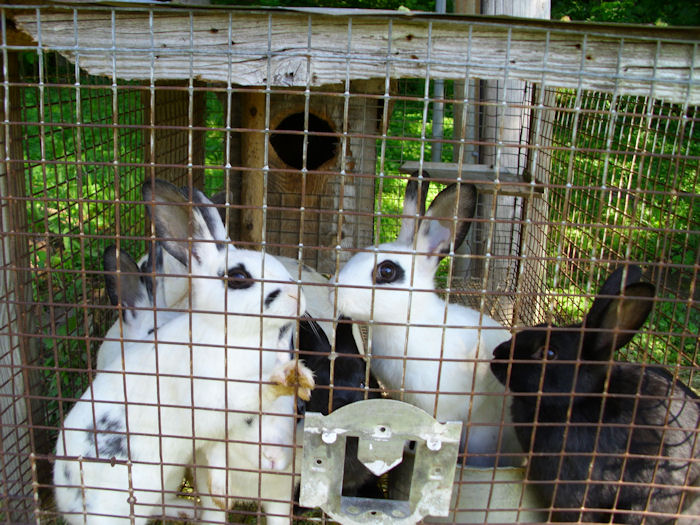You may remember my previous post about Easter Bunnies. At that point, they were hairless and barely recognizable as rabbits. Since that time, our Easter bunnies have continued to grow. After about three weeks the little rabbits will begin jumping out of the nest box. We call them “poppers” at that point. From that point on, the babies begin eating food on their own. It takes between 1 and 1½ months for the doe to ween the babies. At that point, the babies are more or less independent, but still spend plenty of time with mom (who continues to groom them).
The babies are a little over 2 months old now. Mom will remain with the babies for another week or so, and then we’ll remove her. We’ll keep the babies together because they’re used to being together. Keeping the babies together for now will reduce stress. Here’s how the babies look now:
Yes, it’s pretty amazing to see how fast they grow. There are six babies in here. We’ll separate them according to sex once they get a little bigger and put them in separate cages.
Some people wonder why we use such heavy cages. The rabbits are kept outside so they get fresh air and sunshine. (The nest box in the back of the cage is big enough to accommodate all of them in bad weather.) Because the rabbits are outside to be in a healthy environment, they’re at risk from predators. The other day we came home to find two dogs after the rabbits. So, the heavy cages aren’t there to keep the rabbits in, but to keep the predators out. You don’t want you bunnies eaten by any of the huge number of predators that feast on them, so it’s important to build sturdy cages well off the ground.
I’ve had a few people ask what we feed our rabbits. They do get rabbit pellets as one of their main dietary items. However, in addition to the rabbit pellets, we feed them garden scraps, grass hay (grass that we’ve let grow a little long and then raked up), corn (to help them keep their teeth ground down and to provide needed fat), oats (to provide needed fiber), and sticks from our apple and pear trees (a treat that also helps keep their teeth ground down). Each of the cages also has a salt block with minerals (the red blocks—not the solid white ones). We make sure that the rabbits also have clean water (they tend to dirty it by sitting in it at times).
The picture doesn’t show it, but bottom of the cage uses a much smaller mesh (½” × ½”). Otherwise, the rabbits would quickly become footsore and could get infections from cuts. The mesh allows fecal matter to pass through. We wash the cages regularly to keep them clean.

